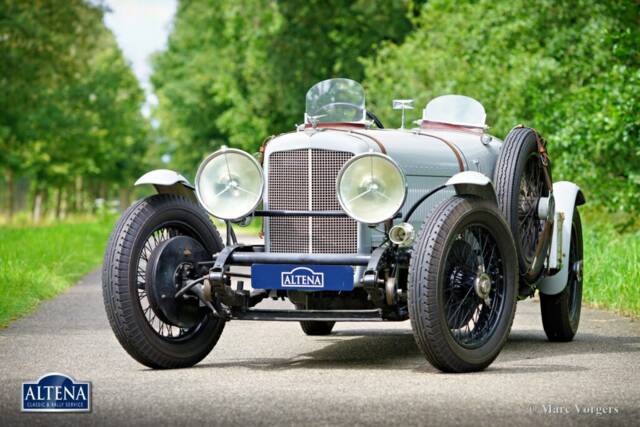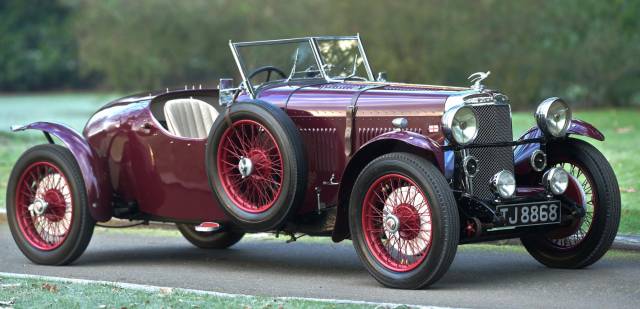Alvis Firebird classic cars for sale
The Alvis Firebird combines British pre-war automotive engineering with a robust four-cylinder engine, lightweight aluminium bodywork, and coachbuilt individuality. Available between 1935 and 1936, the Firebird offers elegant lines, a distinctive driving experience, and true collector appeal for enthusiasts of pre-war British motoring.
Search results
Currently, there are no matching listings for your search.
Create search alert
Let yourself be notified as soon as a listing is published that matches your search filters.
Create listing
Do you have a Alvis Firebird that you want to sell? Then create a listing now.
Create listingAlvis Firebird listing references from Classic Trader
Below you will find listings related to your search that are no longer available on Classic Trader. Use this information to gain insight into availability, value trends, and current pricing for a "Alvis Firebird" to make a more informed purchasing decision.

1935 | Alvis Firebird Sports

1935 | Alvis Firebird Sports
Model SA 13/2

1935 | Alvis Firebird Sports
1935 ALVIS FIREBIRD SPORTS (REF: NR743)
Create search alert
Let yourself be notified as soon as a listing is published that matches your search filters.
Create listing
Do you have a Alvis Firebird that you want to sell? Then create a listing now.
Create listingHistory of Alvis Firebird
Produced by Alvis Ltd in Coventry, the Firebird emerged between 1935 and 1936 as a progressive step from the notable Alvis Firefly. Alvis supplied the Firebird primarily as a rolling chassis, enabling individual coachbuilders—most notably Cross and Ellis—to create bespoke bodystyles tailored to their clients’ preferences. The use of aluminium over an ash wood frame reflected period standards for quality, resulting in strikingly elegant vehicles often completed as four-door open tourers. The Firebird quickly established itself among connoisseurs for its advanced engine design and driving refinement, maintaining a presence within classic car circles and the Alvis Owners' Club.
Model history of the Alvis Firebird
The Firebird was introduced as the successor to the Alvis Firefly, building on its predecessor's foundations with mechanical improvements and a shorter SA chassis. While production continued until 1936, the unique practice of delivering cars as rolling chassis enabled broad diversity in the resulting vehicles. Many Firebirds sported open tourer bodies, a direct influence from period motoring culture. Following its production span, later Alvis models further evolved in design and technology, but the Firebird remains a stand-alone proposition within the wider Alvis range due to its specific engineering and coachbuilt flexibility.
Highlights of the Alvis Firebird
The Firebird is powered by an 1,842 cm³ inline four-cylinder engine with overhead valves (OHV), recognised for its reliability and spirited response in the class. Aluminium bodywork contributed both to agility and corrosion resistance, while the customisation opportunities offered by coachbuilding resulted in high variability across surviving examples, making each Firebird unique to an extent. Period options such as complete all-weather gear with removable side screens and stowing solutions in the boot set the Firebird apart for touring practicality. Its pronounced curvaceous body lines are praised among period aficionados.
Technical data for the Alvis Firebird
Special Editions and Collectible Models
The Firebird was primarily tailored as bespoke vehicles by various coachbuilders, with Cross and Ellis providing a significant number of the open tourer bodies. Some models are particularly noted for their rare bodywork configurations or particularly comprehensive all-weather equipment packages, factors that contribute to their desirability within collector circles.
Weak spots and common issues with the Alvis Firebird
With a construction relying on a wooden ash frame beneath aluminium panels, attention must be paid to chassis and frame condition. Classic British wood-framed vehicles require checks for rot or degradation, especially in cars stored in damp climates. Replacement or restoration of aluminium bodywork and original coachbuilt components can present challenges for authenticity and cost. Mechanical maintenance is relatively straightforward for experienced classic car owners, with good parts availability for engine and drivetrain due to period consistency among many pre-war Alvis models.
Engine, performance and handling characteristics
The Firebird’s 1,842 cm³ inline four, overhead valve engine delivers lively mid-1930s era performance, with notable flexibility and steady torque delivery; period reports praise its performance in both open and closed body forms. The shortened SA chassis enhances responsiveness, especially when equipped with lighter open tourer configurations, while traditional leaf-spring suspension provides the expected period ride. Manual transmission offers direct, mechanical shifting feel, contributing to the driving engagement classic car enthusiasts seek. Particular interest within the Firebird range lies in models bodied by Cross and Ellis, with open tourer bodies offering the most sought-after driving experience. These models combine the robust Alvis mechanical platform with light, stylish bespoke coachwork and often include full touring specification—side screens, all-weather protection, and practical luggage solutions.
Interior, comfort, exterior and design
The Firebird is marked by its sweeping exterior lines, a hallmark of mid-1930s coachbuilt luxury. Aluminium bodywork not only ensures structural lightness but allows for complex panel shaping and curves, which are especially apparent on open tourer versions. Interiors were typically customized, ranging from simple sporting layouts to more luxuriously appointed cabins with trimmed seats, detailed fascia, and custom instrumentation. Special accessories, such as folding windscreens, removable weather gear, and tailored luggage compartments, are common in well-preserved examples. Coachbuilders often employed premium materials—leather, high-quality carpeting, and period correct fittings—that enhance the tactile classic motoring experience.
Other noteworthy aspects of the Alvis Firebird
Because each Firebird left the Alvis works as a rolling chassis, authenticity for any given car is closely tied to the provenance and accuracy of its coachbuilt body and interior fittings. Histories of individual cars are particularly important in this context, with provenance impacting value and collector interest.
Summary of the Alvis Firebird
Available for a short period during the mid-1930s, the Alvis Firebird represents a blend of pre-war British craftsmanship and tailored coachbuilding. With aluminium-over-ash construction, a lively four-cylinder OHV engine, and considerable flexibility in body style, it stands as a distinctive entry both in the Alvis portfolio and among British classic touring cars. Today, the Firebird is prized for its individuality, driving engagement, and historical significance within classic car circles.